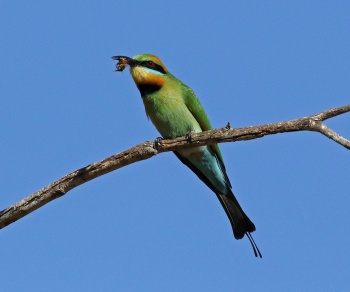- Merops ornatus
Identification
19–21 cm - 7½-8¼ in) (plus the tail streamers of up to 7 cm)
- Long, slim decurved bill
- Bluish tinge to long black tail with tail-streamers
- Golden crown
- Thick black eye-stripe reaching from the bill to the ears, edged with blue
- Orange-yellow throat with a broad black band separating it from a green breast
- Green above
- Coppery, black-tipped flight feathers
- Bright orange underwing, edged black
- Blue lower belly
- Red eye
Sexes are similar but the Female's tail streamers are shorter and thicker than those of the male, in addition there is a thin blue line beneath the black throat band
Immature birds are duller and greener, lacking the black chest band and the long tail streamers.
Distribution
Australia, eastern Indonesia, New Guinea and, occasionally, the Solomon Islands. Winters to Northern Australia, Sulawesi, the Banda Arc and New Guinea.
Taxonomy
This is a monotypic species[1].
Habitat
Open forests, woodlands and shrublands, and cleared areas, usually near water.
Behaviour
Diet
The diet consists of insects, mainly bees and wasps, as well as dragonflies, beetles, butterflies and moths.
Breeding
The nest site is chosen jointly by the pair. A long tunnel is dug into a sandy bank, terminating in a nest chamber, which is then lined with grass. The eggs and young are tended by both parents.
Voice
Loud series of "Prr-Prr" calls increasing to a crescendo before descending, sometimes continuous and slurred, interspaced with quieter single "Prr" sounds. Mainly silent on wintering grounds.
Gallery
Click on photo for larger image
Photo © by Mike Bouette
Nullagine river, Nr Marble Bar, Western Australia, September 2015
References
- Clements, J. F., T. S. Schulenberg, M. J. Iliff, D. Roberson, T. A. Fredericks, B. L. Sullivan, and C. L. Wood. 2018. The eBird/Clements checklist of birds of the world: v2018. Downloaded from http://www.birds.cornell.edu/clementschecklist/download/
- Handbook of the Birds of the World Alive (retrieved Mar 2018)
- Birds in Backyards
- eBird Range maps, https://ebird.org/species
- Macaulay Library, https://www.macaulaylibrary.org
Recommended Citation
- BirdForum Opus contributors. (2025) Rainbow Bee-eater. In: BirdForum, the forum for wild birds and birding. Retrieved 28 April 2025 from https://www.birdforum.net/opus/Rainbow_Bee-eater
External Links
Search the Gallery using the scientific name:
Search the Gallery using the common name:
GSearch checked for 2020 platform.







